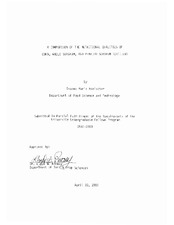| dc.description.abstract | Sorghum has been shown to produce tortillas comparable to the traditional corn tortilla. Sorghum has been found to have a lower feed efficiency than corn. This study examined, for the first time, the nutritional quality of sorghum when processed into tortillas and compared it with the corn tortilla.
Tortillas were made from corn, whole sorghum, and pearled sorghum. Fifteen percent of the outer layers of the sorghum kernel were removed during the pearling process. A longer cooking time was required for the corn tortilla. The pearled sorghum was soaked in water and alkali prior to cooking; it cooked for only 4 minutes.
Organoleptic properties of the tortillas were evaluated with a taste panel. Acceptance of the sorghum tortillas were about half of the acceptance of the corn tortillas, although none were disliked extremely in any case. The whole sorghum tortillas were dark in color. Pearling seemed to improve the color of the tortillas, but the pearled tortillas were still darker than the corn tortillas. A white sorghum, such as the one that was used in this study, does not always produce a tortilla of acceptable color. Environment can influence polyphenol content and thus, influence color of the finished product. The corn had a higher protein content than the sorghum (8.38 compared to 6.69). Pearling removed some of the pericarp proteins to lower the protein level of the decorticated grain to 6.3. The protein content of all of the grains increased during the processing due to loss of starch. Calcium levels also increased during cooking because of addition of CaO. The pearled sorghum have slightly lower amounts of the Si, P, Mg, and K.
In vivo analysis was attempted using a modified Protein Efficiecy Ratio. Moisture and fiber contents of the diets were raised to 10 and 2 % respectively. Casein supplementation to reach a level of 9% protein in the diet was needed for both the grains and the tortillas. Modified PERs (mPERs) for the sorghum fed rats were higher than corn. Corn tortilla fed rats had slightly higher mPERs than both groups of sorghum tortilla fed rats. However, since the corn and sorghum results conflict directly with the values in the literature, these trials should not be accepted without further experimentation. | en |


